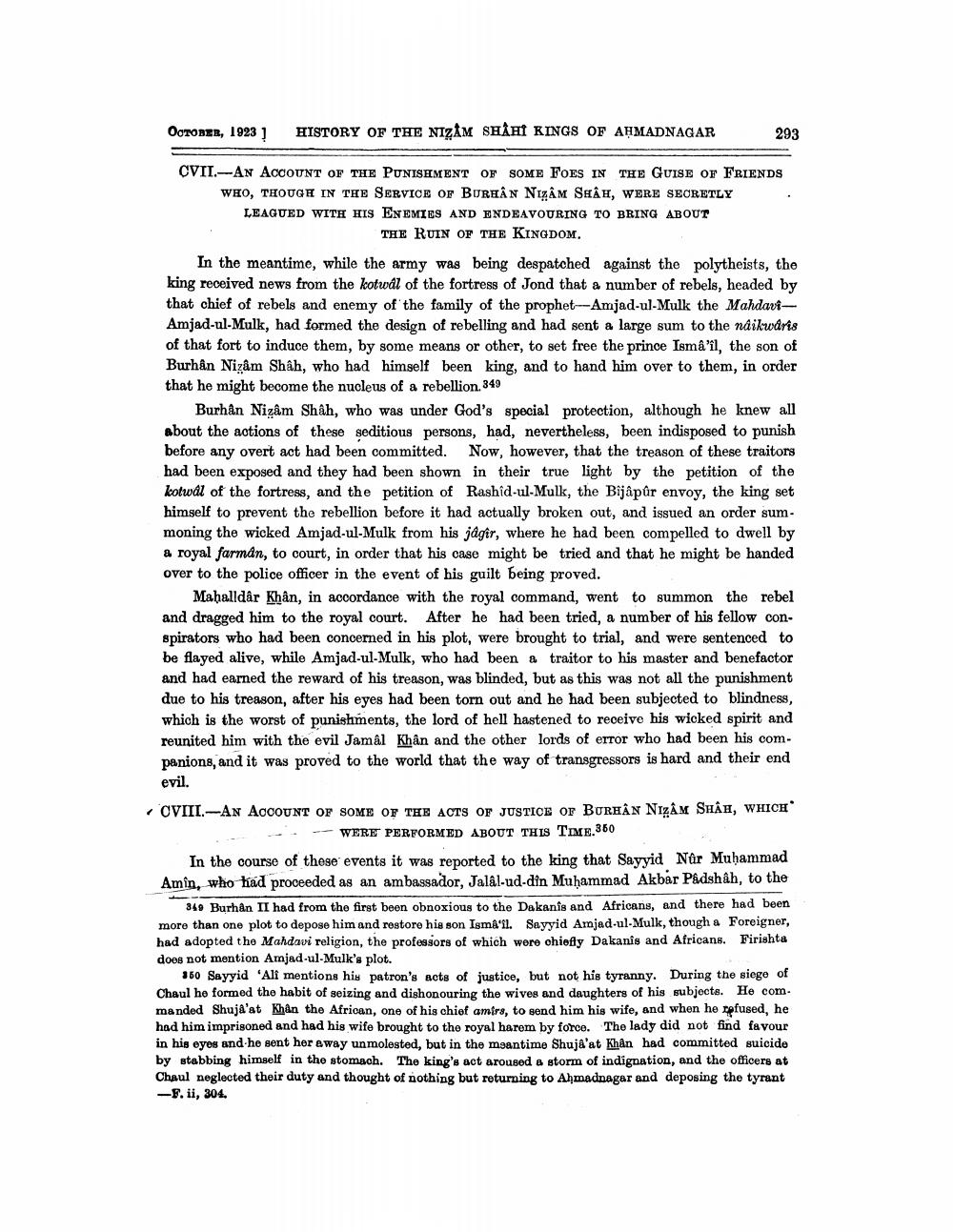________________
Оотовкв, 1923 1
HISTORY OF THE NIZAM SHAHI KINGS OF AHMADNAGAR
CVII.-AN ACCOUNT OF THE PUNISHMENT OF SOME FOES IN THE GUISE OF FRIENDS WHO, THOUGH IN THE SERVICE OF BURHAN NIZAM SHAH, WERE SECRETLY
LEAGUED WITH HIS ENEMIES AND ENDEAVOURING TO BRING ABOUT THE RUIN OF THE KINGDOM.
293
In the meantime, while the army was being despatched against the polytheists, the king received news from the kotwal of the fortress of Jond that a number of rebels, headed by that chief of rebels and enemy of the family of the prophet-Amjad-ul-Mulk the MahdaviAmjad-ul-Mulk, had formed the design of rebelling and had sent a large sum to the naikwâris of that fort to induce them, by some means or other, to set free the prince Ismâ'îl, the son of Burhân Nizam Shah, who had himself been king, and to hand him over to them, in order that he might become the nucleus of a rebellion. 349
Burhân Nizam Shah, who was under God's special protection, although he knew all about the actions of these seditious persons, had, nevertheless, been indisposed to punish before any overt act had been committed. Now, however, that the treason of these traitors had been exposed and they had been shown in their true light by the petition of the kotwal of the fortress, and the petition of Rashid-ul-Mulk, the Bijâpûr envoy, the king set himself to prevent the rebellion before it had actually broken out, and issued an order summoning the wicked Amjad-ul-Mulk from his jagir, where he had been compelled to dwell by a royal farman, to court, in order that his case might be tried and that he might be handed over to the police officer in the event of his guilt being proved.
Mahalldar Khân, in accordance with the royal command, went to summon the rebel and dragged him to the royal court. After he had been tried, a number of his fellow conspirators who had been concerned in his plot, were brought to trial, and were sentenced to be flayed alive, while Amjad-ul-Mulk, who had been a traitor to his master and benefactor and had earned the reward of his treason, was blinded, but as this was not all the punishment due to his treason, after his eyes had been torn out and he had been subjected to blindness, which is the worst of punishments, the lord of hell hastened to receive his wicked spirit and reunited him with the evil Jamâl Khân and the other lords of error who had been his companions, and it was proved to the world that the way of transgressors is hard and their end evil.
CVIII-AN ACCOUNT OF SOME OF THE ACTS OF JUSTICE OF BURHAN NIZAM SHAH, WHICH WERE PERFORMED ABOUT THIS TIME.350
In the course of these events it was reported to the king that Sayyid Nur Muḥammad Amin, who had proceeded as an ambassador, Jalâl-ud-din Muḥammad Akbar Pâdshah, to the
349 Burhan II had from the first been obnoxious to the Dakanîs and Africans, and there had been more than one plot to depose him and restore his son Ismail. Sayyid Amjad-ul-Mulk, though a Foreigner, had adopted the Mahdavi religion, the professors of which were chiefly Dakanis and Africans. Firishta does not mention Amjad-ul-Mulk's plot.
350 Sayyid 'Ali mentions his patron's acts of justice, but not his tyranny. During the siege of Chaul he formed the habit of seizing and dishonouring the wives and daughters of his subjects. He commanded Shuja'at Khân the African, one of his chief amirs, to send him his wife, and when he refused, he had him imprisoned and had his wife brought to the royal harem by force. The lady did not find favour in his eyes and he sent her away unmolested, but in the meantime Shuja'at Khân had committed suicide by stabbing himself in the stomach. The king's act aroused a storm of indignation, and the officers at Chaul neglected their duty and thought of nothing but returning to Ahmadnagar and deposing the tyrant -F. ii, 304.




